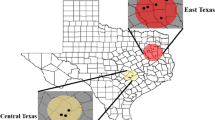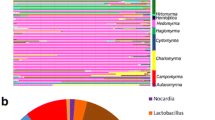Abstract
We reconstruct the phylogenetic relationships within the bacterial genus Pseudonocardia to evaluate two models explaining how and why Pseudonocardia bacteria colonize the microbial communities on the integument of fungus-gardening ant species (Attini, Formicidae). The traditional Coevolution-Codivergence model views the integument-colonizing Pseudonocardia as mutualistic microbes that are largely vertically transmitted between ant generations and that supply antibiotics that specifically suppress the garden pathogen Escovopsis. The more recent Acquisition model views Pseudonocardia as part of a larger integumental microbe community that frequently colonizes the ant integument from environmental sources (e.g., soil, plant material). Under this latter model, ant-associated Pseudonocardia may have diverse ecological roles on the ant integument (possibly ranging from pathogenic, to commensal, to mutualistic) and are not necessarily related to Escovopsis suppression. We test distinct predictions of these two models regarding the phylogenetic proximity of ant-associated and environmental Pseudonocardia. We amassed 16S-rRNA gene sequence information for 87 attine-associated and 238 environmental Pseudonocardia, aligned the sequences with the help of RNA secondary structure modeling, and reconstructed phylogenetic relationships using a maximum-likelihood approach. We present 16S-rRNA secondary structure models of representative Pseudonocardia species to improve sequence alignments and identify sequencing errors. Our phylogenetic analyses reveal close affinities and even identical sequence matches between environmental Pseudonocardia and ant-associated Pseudonocardia, as well as nesting of environmental Pseudonocardia in subgroups that were previously thought to be specialized to associate only with attine ants. The great majority of ant-associated Pseudonocardia are closely related to autotrophic Pseudonocardia and are placed in a large subgroup of Pseudonocardia that is known essentially only from cultured isolates (rather than cloned 16S sequences). The preponderance of the known ant-associated Pseudonocardia in this latter clade of culturable lineages may not necessarily reflect abundance of these Pseudonocardia types on the ants, but isolation biases when screening for Pseudonocardia (e.g., preferential isolation of autotrophic Pseudonocardia with minimum-nutrient media). The accumulated phylogenetic patterns and the possibility of isolation biases in previous work further erode support for the traditional Coevolution-Codivergence model and calls for continued revision of our understanding how and why Pseudonocardia colonize the microbial communities on the integument of fungus-gardening ant species.




Similar content being viewed by others
References
Acinas SG, Sarma-Rupavtarm R, Klepac-Ceraj V, Polz MF (2005) PCR-induced sequence artifacts and bias: insights from comparison of two 16S rRNA clone libraries constructed from the same sample. Appl Environ Microbiol 71:8966–8969
Bacci M, Ribeiro SB, Casarotto MEF, Pagnocca FC (1995) Biopolymer-degrading bacteria from nests of the leaf-cutting ant Atta sexdens rubropilosa. Braz J Med Biol Res 28:79–82
Boomsma JJ, Aanen DK (2009) Rethinking crop-disease management in fungus-growing ants. Proc Natl Acad Sci USA 106:17611–17612
Cafaro MJ, Currie CR (2005) Phylogenetic analysis of mutualistic filamentous bacteria associated with fungus-growing ants. Can J Microbiol 51:441–446
Caldera EJ, Poulsen M, Suen G, Currie CR (2009) Insect symbioses: a case study of past, present, and future fungus-growing ant research. Environ Entomol 38:78–92
Cannone JJ, Subramanian S, Schnare MN, Collett JR, D’Souza LM, Du Y, Feng B, Lin N, Madabusi LV, Müller KM, Pande N, Shang Z, Yu N, Gutell RR (2002) The comparative RNA Web (CRW) site: an online database of comparative sequence and structure information for ribosomal, intron, and other RNAs. BioMed Cen Bioinformatics 3:2
Carreiro SC, Pagnocca FC, Bueno OC, Bacci M, Hebling MJA, da Silva OA (1997) Yeasts associated with the nests of the leaf-cutting ant Atta sexdens rubropilosa Forel, 1908. Antonie van Leeuwenhoek 71:243–248
Currie CR (2001) A community of ants, fungi, and bacteria: a multilateral approach to studying symbiosis. Annu Rev Microbiol 55:357–380
Currie CR, Mueller UG, Malloch D (1999a) The agricultural pathology of ant fungus gardens. Proc Natl Acad Sci USA 96:7998–8002
Currie CR, Scott JA, Summerbell RC, Malloch D (1999b) Fungus-growing ants use antibiotic-producing bacteria to control garden parasites. Nature 398:701–704
Currie CR, Bot ANM, Boomsma JJ (2003) Experimental evidence of a tripartite mutualism: bacteria protect ant fungus gardens from specialized parasites. Oikos 101:91–102
Currie CR, Poulsen M, Mendenhall J, Boomsma JJ, Billen J (2006) Coevolved crypts and exocrine glands support mutualistic bacteria in fungus-growing ants. Science 311:81–83
Dattagupta S, Schaperdoth I, Montanari A, Mariani S, Kita N, Valley JW, Macalady JL (2009) A novel symbiosis between chemoautotrophic bacteria and a freshwater cave amphipod. Int Soc Microb Ecol 3:935–943
Diamond J (2006) Virus and the whale: exploring evolution in creatures small and large. National Science Teachers Association Press, Arlington, VA
Fernández-Marín H, Zimmerman JK, Nash DR, Boomsma JJ, Wcislo WT (2009) Reduced biological control and enhanced chemical pest management in the evolution of fungus farming in ants. Proc R Soc Lond B 276:2236–2269
Goodfellow M, Williams ST (1983) Ecology of actinomycetes. Annu Rev Microbiol 37:189–216
Gould SJ, Lewontin RC (1979) The spandrels of San Marco and the Panglossian Paradigm: a critique of the Adaptationist Programme. Proc R Soc Lond B 205:581–598
Gutell RR, Weiser B, Woese CR, Noller HF (1985) Comparative anatomy of 16S-like ribosomal RNA. Prog Nucl Acid Res Mol Biol 32:155–216
Gutell RR, Power A, Hertz G, Putz E, Stormo G (1992) Identifying constraints on the higher-order structure of RNA: continued development and application of comparative sequence analysis methods. Nucleic Acids Res 20:5785–5795
Gutell RR, Larsen N, Woese CR (1994) Lessons from an evolving ribosomal RNA: 16S and 23S rRNA structure from a comparative perspective. Microbiol Rev 58:10–26
Gutell RR, Lee JC, Cannone JJ (2002) The accuracy of ribosomal RNA comparative structure models. Curr Opin Struct Biol 12:301–310
Haeder S, Wirth R, Herz H, Spiteller D (2009) Candicidin-producing Streptomyces support leaf-cutting ants to protect their fungus garden against the pathogenic fungus Escovopsis. Proc Natl Acad Sci USA 106:4742–4746
Hamady M, Knight R (2009) Microbial community profiling for human microbiome projects: tools, techniques, and challenges. Genome Res 19:1141–1152
Huang Y, Goodfellow M (2011) Genus I. Pseudonocardia (Henssen 1957, 408AL) emend. Park, Park, Lee and Kim 2008, 2477VP. In: Goodfellow M, Kämpfer P, Busse H-J, Trujillo M, Suzuki K, Ludwig W, Whitman WB (eds) Bergey's manual of systematic bacteriology, 2nd ed., vol 5: the actinobacteria. Springer, New York (in press)
Kost C, Lakatos T, Böttcher I, Arendholz W-R, Redenbach M, Wirth R (2007) Non-specific association between filamentous bacteria and fungus-growing ants. Naturwissenschaften 94:821–828
Lee SD, Kim ES, Hah YC (2000) Phylogenetic analysis of the genera Pseudonocardia and Actinobispora based on 16S ribosomal DNA sequences. FEMS Microbiol Lett 182:125–129
Maddison DR, Maddison WP (2000) MacClade 4: analysis of phylogeny and character evolution. Sinauer Associates, Sunderland, MA
McVeigh HP, Munro J, Embley TM (1994) The phylogenetic position of Pseudoamycolata halophobica (Akimov et al. 1989) and a proposal to reclassify it as Pseudonocardia halophobica. Int J Syst Bacteriol 44:300–302
Mueller UG, Gerardo NM, Aanen DK, Six DL, Schultz TR (2005) The evolution of agriculture in insects. Ann Rev Ecol Evol Sys 36:563–595
Mueller UG, Dash D, Rabeling C, Rodrigues A (2008) Coevolution between attine ants and actinomycete bacteria: a reevaluation. Evolution 62:2894–2912
Oh D-C, Poulsen M, Currie CR, Clardy J (2009) Dentigerumycin: a bacterial mediator of an ant-fungus symbiosis. Nat Chem Biol 5:391–393
Olsen GJ, Overbeek R, Larsen N, Marsh TL, McCaughey MJ, Maciukenas MA, Kuan WM, Macke TJ, Xing Y, Woese CR (1992) The ribosomal database project. Nucleic Acids Res 20 suppl:2199–2200
Park SW, Park ST, Lee JE, Kim YM (2008) Pseudonocardia carboxydivorans sp. nov., a carbon monoxide-oxidizing actinomycete, and an emended description of the genus Pseudonocardia. Int J Syst Evol Microbiol 58:2475–2478
Posada DK, Crandall A (1998) Model selection and model averaging in phylogenetics: advantages of the AIC and Bayesian approaches over likelihood ratio tests. Bioinformatics 14:817–818
Poulsen M, Erhardt DP, Molinaro DJ, Ting-Li L, Currie CR (2007) Antagonistic bacterial interactions help shape host-symbiont dynamics within the fungus-growing ant-microbe mutualism. PLoS ONE 2:e960
Poulsen M, Little AEF, Currie CR (2009) Fungus-growing ant-microbe symbiosis: using microbes to defend beneficial associations with symbiotic communities. In: White JF, Torres MS (eds) Defensive mutualism in microbial symbiosis. CRC Press, Boca Raton, pp 149–162
Rodrigues A, Bacci M, Mueller UG, Ortiz A, Pagnocca FC (2008) Microfungal “weeds” in the leafcutter ant symbiosis. Microb Ecol 56:604–614
Rodrigues A, Cable RN, Mueller UG, Bacci M, Pagnocca FC (2009) Antagonistic interactions between garden yeasts and microfungal garden pathogens of leaf-cutting ants. Antonie Leeuwenhook 96:331–342
Santos AV, Dillon RJ, Dillon VM, Reynolds SE, Samuels RI (2004) Occurrence of the antibiotic producing bacterium Burkholderia sp. in colonies of the leaf-cutting ant Atta sexdens rubropilosa. FEMS Microbiol Lett 239:319–323
Sen R, Ishak HD, Estrada D, Dowd SE, Hong E, Mueller UG (2009) Generalized antifungal activity and 454-screening of Pseudonocardia and Amycolatopsis bacteria in nests of fungus-growing ants. Proc Natl Acad Sci USA 106:17805–17810
Stomeo F, Portillo MC, Gonzalez JM, Laiz L, Saiz-Jimenez C (2008) Pseudonocardia in white colonizations in two caves with Paleolithic paintings. Int Biodeterior Biodegradation 62:483–486
Suen G, Currie CR (2008) Ancient fungal farmers of the insect world. Microbiol Today 35:172–175
Warwick S, Bowen T, McVeigh H, Embley TM (1994) A phylogenetic analysis of the family Pseudonocardiaceae and the genera Actinokineospora and Saccharothrix with 16S rRNA sequences and a proposal to combine the genera Amycolata and Pseudonocardia in an emended genus Pseudonocardia. Int J Syst Bacteriol 44:293–299
Woese CR (2000) Interpreting the universal phylogenetic tree. Proc Natl Acad Sci USA 97:8392–8396
Woese CR, Magrum LJ, Gupta R, Siegel RB, Stahl DA, Kop J, Crawford N, Brosius R, Gutell R, Hogan JJ, Noller HF (1980) Secondary structure model for bacterial 16S ribosomal RNA: phylogenetic, enzymatic and chemical evidence. Nucleic Acids Res 8:2275–2294
Woese CR, Gutell R, Gupta R, Noller HF (1983) Detailed analysis of the higher-order structure of 16S-like ribosomal ribonucleic acids. Microbiol Rev 47:621–669
Zhang M, Poulsen M, Currie CR (2007) Symbiont recognition of mutualistic bacteria in Acromyrmex leaf-cutting ants. Int Soc Microb Ecol J 1:313–320
Zwickl DJ (2006) Genetic algorithm approaches for the phylogenetic analysis of large biological sequence datasets under the maximum likelihood criterion. Ph.D. dissertation, The University of Texas at Austin
Acknowledgements
We thank Linquan Bai and Amanda Jones for the invitation to contribute to this special issue honoring Mike Goodfellow and his lifetime contribution to actinomycete ecology, systematics, and evolution. We thank Linda Kinkel, Liz Wellington, and Linquan Bai for the invitation to give a plenary talk at the 2009 ISBA Congress in Shanghai, for which we developed many ideas presented here. We thank two anonymous reviewers for constructive comments on the manuscript. The research was supported by NSF awards DEB-0919519, DEB-0639879, and DEB-0110073 to UGM; and NIH award R01GM067317 to RRG.
Author information
Authors and Affiliations
Corresponding author
Electronic supplementary material
Below is the link to the electronic supplementary material.
Rights and permissions
About this article
Cite this article
Mueller, U.G., Ishak, H., Lee, J.C. et al. Placement of attine ant-associated Pseudonocardia in a global Pseudonocardia phylogeny (Pseudonocardiaceae, Actinomycetales): a test of two symbiont-association models. Antonie van Leeuwenhoek 98, 195–212 (2010). https://doi.org/10.1007/s10482-010-9427-3
Received:
Accepted:
Published:
Issue Date:
DOI: https://doi.org/10.1007/s10482-010-9427-3




